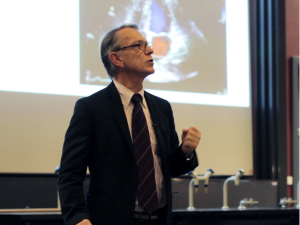Selenium is an essential trace element. Essential means that sufficient selenium is necessary for normal cell functioning and that our bodies cannot synthesize selenium for us. We must get it from our diets. Trace element means selenium is a micronutrient that is needed in very small quantities, in microgram quantities. It may be an important element to slow the ageing process.

Sufficient selenium status plays an important role in the prevention of cardiovascular diseases, inflammation, and infections. Prof. Margaret P. Rayman, University of Surrey, estimates that serum/plasma selenium status of around 125 mcg/L is optimal for human health [Rayman 2020].
The beneficial work of selenium in the cells and tissues is done by selenoproteins that contain the amino acid selenocysteine in the active center. Among the selenoproteins known to have an antioxidant effect in the body are the glutathione peroxidases (GPX1-4 and GPX6) and the thioredoxin reductases (TXNRD1-3) [Alehagen 2021].
Need for Selenium in the Senior Years
Ageing as a process involves numerous changes at the cellular and molecular levels. Ageing involves changes in cells, mitochondria, proteins, stem cells, and telomeres; mostly, the changes are of a degenerative nature.
The changes are associated with mild to moderate systemic inflammation. Ageing also involves an imbalance between antioxidative defense substances and reactive oxygen species, popularly known as free radicals.
Prof. Urban Alehagen notes that oxidative stress, inflammation, and ageing interact with one other in a complex way. Oxidative stress and inflammation are risk factors for such diseases as cancer, cardiovascular disease, and dementia [Alehagen 2021].
Oxidative Stress and Inflammation Associated with Ageing
Supplementation of low-selenium-status individuals — selenium status below 100 mcg/L — with selenium from selenium yeast can enhance antioxidant status and can alleviate inflammation.

In the Swedish KiSel-10 Study, four years of combined supplementation with 200 mcg/day of selenium and 2 x 100 mg/day of Coenzyme Q10 were associated with the reduction or normalization of such biomarkers for inflammation as C-Reactive Protein, P-selectin, and osteoprotegerin. The combined supplementation regime in the KiSel-10 Study was also associated with increases in insulin-like growth factor 1 (IGF-1), which is considered to be a central biomarker in nutrition and inflammation [Alehagen 2021].
Professor Alehagen notes that the status of the sirtuin family (SIRT1 – SIRT7) of signaling proteins has been associated with longevity. Sirtuins are involved in such age-related processes as control of oxidative stress responses and inflammatory responses. At present, the mechanism by which selenium status is linked to sirtuins is not known. More research is needed on the impact of selenium on oxidative stress and inflammation and its role in anti-ageing [Alehagen 2021].
Risk of Cardiovascular Disease Associated with Ageing
In the BIOSTAT-CHF prospective cohort study, heart failure patients who were deficient in selenium (less than 70 mcg/L in serum) had worse New York Heart Association functional class, less exercise capacity, and lower quality of life than heart failure patients with higher serum selenium concentrations. In fact, the researchers observed that the clinical condition of heart failure patients with serum selenium concentrations below 100 mcg/L was nearly as bad as the clinical condition of heart failure patients with serum selenium levels below 70 mcg/L. Accordingly, serum selenium concentrations below 100 mcg/L would seem to deserve attention as a warning sign [Bomer 2020].
In the Malmö Preventive Project, a prospective cohort study enrolling 4366 individuals who were followed up for nine years, researchers found that the risk of all-cause mortality, cardiovascular mortality, and a first-time adverse cardiovascular event were all inversely associated with the plasma Selenoprotein P concentration [Schomburg 2019].
Kuria et al conducted a meta-analysis of five cohort studies and concluded that higher selenium status significantly reduced cardiovascular incidence and mortality, compared to lower selenium status [Kuria 2020a]. A second meta-analysis of 16 observational studies has shown an inverse association between adverse cardiovascular events and selenium levels up to 106 mcg/L [Zhang ].
Risk of Degenerative Disease Associated with Ageing
What do we know about neurodegenerative diseases such as Alzheimer’s and Parkinson’s disease?
- Ageing is, itself, a significant risk factor for suffering one of these neurodegenerative disorders.
- Mitochondrial dysfunction and oxidative stress have been suggested as biological mechanisms linking ageing and neurodegenerative diseases.
- Elevated levels of harmful free radicals seem to play a role in the
development of Alzheimer’s and Parkinson’s disease. - Antioxidant enzymes containing selenium compounds protect against oxidative damage caused by harmful free radicals.
- Epidemiological studies indicate that selenoproteins protect against cognitive decline.
- The results of a 2019 meta-analysis have shown that the brain tissues of Alzheimer’s patients have decreased levels of selenium compared to the brain tissues of individuals who do not have Alzheimer’s [Varikasuvu 2019].
- We need evidence from controlled clinical trials before we draw any definite
conclusions about the protective role of selenium in degenerative diseases.
Risk of Other Ageing-related diseases
Prof. Alehagen points to the association between selenium deficiency and other ageing-related diseases [Alehagen 2021].
- Sub-optimal intakes of selenium are associated with an increased risk of certain cancers [Cai 2016]. The biological mechanisms by which sufficient selenium status protects against certain cancers are not known; however, one explanation may be protection against oxidative stress and inflammation. A 2020 meta-analysis of population-based prospective studies has shown an inverse relationship between selenium intake and overall cancer risk after adjusting for age, body mass index, and smoking [Kuria 2020b].
- Increased risk of reduced kidney function and renal failure is associated with ageing. There is a close relationship between selenium status and renal function. Moreover, hemodialysis can lead to a decrease in selenium levels in the body. Selenium supplementation has been shown to increase significantly plasma selenium concentrations and plasma glutathione peroxidase levels and to normalize IL-6 levels [Alehagen 2021].
- Selenium deficiency has been associated with the development of several viral infections. The antioxidant selenoproteins, e.g., the glutathione peroxidases and the thioredoxin reductases seem important for protection against viral infections [Guillin 2019].
Conclusion: Selenium and Biological Ageing
The current evidence seems to suggest that individuals with serum/plasma selenium levels below 100 mcg/L should be considered to have sub-optimal selenium status [Al-Mubarak 2021].
Selenium reduces the levels of systemic inflammation, suppresses oxidative stress, decreases DNA damage, and promotes telomere length [Alehagen 2021]. It may contribute to a slowing of the ageing process.
Sources
Alehagen U, Opstad TB, Alexander J, Larsson A, Aaseth J. Impact of selenium on biomarkers and clinical aspects related to ageing. A Review. Biomolecules. 2021 Oct 7;11(10):1478.
Al-Mubarak AA, van der Meer P, Bomer N. Selenium, Selenoproteins, and Heart Failure: Current Knowledge and Future Perspective. Curr Heart Fail Rep. 2021;18(3):122-131.
Bomer N, Grote Beverborg N, Hoes MF, Streng KW, Vermeer M, Dokter MM, IJmker J, Anker SD, Cleland JGF, Hillege HL, Lang CC, Ng LL, Samani NJ, Tromp J, van Veldhuisen DJ, Touw DJ, Voors AA, van der Meer P. Selenium and outcome in heart failure. Eur J Heart Fail. 2020 Aug;22(8):1415-1423.
Cai X, Wang C, Yu W, Fan W, Wang S, Shen N, Wu P, Li X, Wang F. Selenium Exposure and Cancer Risk: an Updated Meta-analysis and Meta-regression. Sci Rep. 2016 Jan 20;6:19213.
Guillin OM, Vindry C, Ohlmann T, Chavatte L. Selenium, Selenoproteins and Viral Infection. Nutrients. 2019;11(9):2101.
Kuria A., Tian H., Li M., Wang Y., Aaseth J.O., Zang J., Cao Y. Selenium status in the body and cardiovascular disease: A systematic review and meta-analysis. Crit. Rev. Food Sci. Nutr. 2020a:1–10.
Kuria A, Fang X, Li M, Han H, He J, Aaseth JO, Cao Y. Does dietary intake of selenium protect against cancer? A systematic review and meta-analysis of population-based prospective studies. Crit Rev Food Sci Nutr. 2020b;60(4):684-694.
Schomburg L, Orho-Melander M, Struck J, Bergmann A, Melander O. Selenoprotein-P deficiency predicts cardiovascular disease and death. Nutrients. 2019;11:1852.
Varikasuvu SR, Prasad VS, Kothapalli J, Manne M. Brain selenium in Alzheimer’s Disease (BRAIN SEAD Study): A systematic
review and meta-analysis. Biol. Trace Elem. Res. 2019, 189, 361–369.
Zhang X, Liu C, Guo J, Song Y. Selenium status and cardiovascular diseases: meta-analysis of prospective observational studies and randomized controlled trials. Eur J Clin Nutr. 2016;70(2):162–169.
The information presented in this review article is not intended as medical advice and should not be used as such.
15 April 2022
